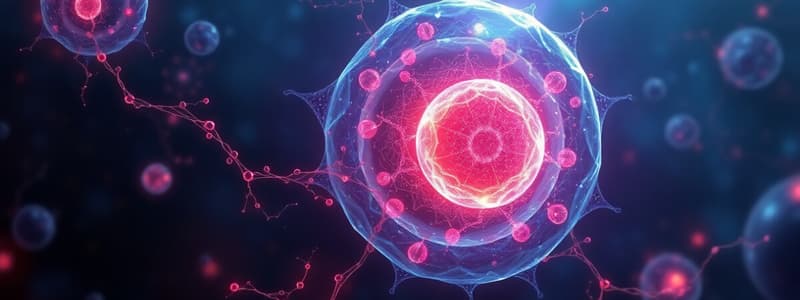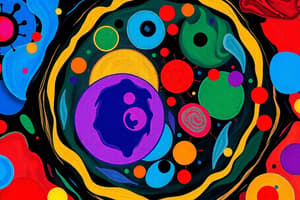Podcast
Questions and Answers
What limits cell size?
What limits cell size?
- Energy consumption
- Surface area to volume ratio (correct)
- Presence of organelles
- Shape of the cell
What occurs during the S Phase of the cell cycle?
What occurs during the S Phase of the cell cycle?
- DNA is copied (correct)
- The nucleus divides
- Cell splits into two
- Mitochondria replicate
Which of the following is true about plant cells?
Which of the following is true about plant cells?
- They have a cell wall and chloroplasts (correct)
- They lack a cell membrane
- Only plant cells have mitochondria
- Plant cells can move freely
What is evolution primarily driven by?
What is evolution primarily driven by?
What is a key characteristic of life?
What is a key characteristic of life?
Flashcards
What is the cell theory?
What is the cell theory?
The idea that all living things are made of cells, cells are the basic unit of life and new cells come from old cells.
What is mitosis?
What is mitosis?
The process where a cell's nucleus divides into two, making sure each new cell gets a complete copy of the DNA.
What are mutations?
What are mutations?
Changes in DNA that can create differences between organisms. These differences can be passed down to offspring and play a role in evolution.
What is evolution?
What is evolution?
Signup and view all the flashcards
How do we classify organisms?
How do we classify organisms?
Signup and view all the flashcards
Study Notes
Cell Size and Function
- Cells are small because their volume increases faster than their surface area.
- Small cells efficiently move nutrients and waste.
The Cell Cycle
- S Phase: DNA is duplicated.
- Mitosis: The cell nucleus divides.
- Cytokinesis: The cell splits into two, producing identical daughter cells.
Limits on Cell Size
- Surface area-to-volume ratio.
- Efficiency of moving materials within the cell.
- DNA efficiency.
Mitosis
- Mitosis ensures that daughter cells have the exact same DNA as the parent cell.
The Cell Theory
- All living things are composed of cells.
- Cells are the smallest fundamental units of life.
- New cells are made from pre-existing cells.
Plant and Animal Cell Differences
- Only plant cells have cell walls and chloroplasts.
- Both plant and animal cells have cell membranes and mitochondria.
The Cell Membrane
- The cell membrane is composed of fats (phospholipids) with water-attracting heads and water-repelling tails.
- It regulates the passage of materials into and out of the cell.
Protein Synthesis
- Ribosomes build proteins.
- The Golgi apparatus packages and transports proteins.
Evolution
- Species change over time due to natural selection.
- Example: Birds with longer beaks survive better if food is deep in trees.
New Species Formation
- Geographic Isolation: A barrier separates a population.
- Reproductive Isolation: Populations stop interbreeding.
Mutations
- Mutations are changes in DNA.
- Mutations can drive evolution by creating variations.
Darwin's Observations
- Island animals are similar to mainland animals but adapted to their new environment.
Classification of Organisms
- Scientific names are used (e.g., Felis catus for cats).
- Archaea and bacteria are both single-celled, but Archaea have different cell wall structures.
Characteristics of Life
- Composed of cells.
- Respond to their environment.
- Grow, reproduce, and use energy.
Kingdom Differences
- Animals move and obtain their food.
- Plants stay in one place and produce their own food using sunlight.
Studying That Suits You
Use AI to generate personalized quizzes and flashcards to suit your learning preferences.
Description
Explore the fascinating world of cells in this quiz covering their size, structure, and the cell cycle. Learn about mitosis, the cell theory, and the distinctions between plant and animal cells. Test your knowledge on how these fundamental units of life operate and replicate.




